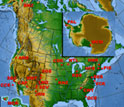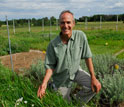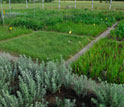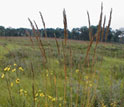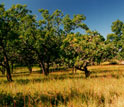News Release 12-086
Plant Diversity Is Key to Maintaining Productive Vegetation
Long-term study finds that each species plays a role in maintaining a productive ecosystem
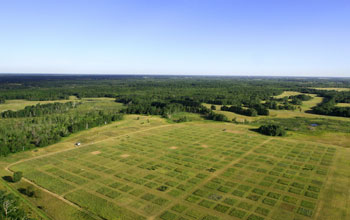
NSF Cedar Creek LTER site experiments show what makes prairies and forests most productive.
May 3, 2012
This material is available primarily for archival purposes. Telephone numbers or other contact information may be out of date; please see current contact information at media contacts.
Vegetation, such as a patch of prairie or a forest stand, is more productive in the long run when more plant species are present, results of a new study show.
The long-term study of plant biodiversity found that each species plays a role in maintaining a productive ecosystem, especially when a long time horizon is considered.
The research found that every additional species in a plot contributed to a gradual increase in both soil fertility and biomass production over a 14-year period.
This week's issue of the journal Science publishes the results. They highlight the importance of managing for diversity in prairies, forests and crops, according to Peter Reich, lead author of the paper and a forest ecologist at the University of Minnesota.
Reich and colleagues looked at how the effect of diversity on productivity of plants changed over the long-term.
Two large field experiments were conducted at the National Science Foundation's (NSF) Cedar Creek Long-Term Ecological Research (LTER) site in Minnesota, one of 26 such NSF LTER sites around the globe in ecosystems from forests to grasslands, tundra to coral reefs.
"This study reveals what short-term experiments have missed: that the effects of biodiversity loss on ecosystems are more complex, severe and unpredictable than previously thought," says Matt Kane, an NSF LTER program director.
"The work shows the importance of doing long-term research," says Kane, "in this case documenting for the first time the critical importance of biodiversity for ecosystem health and sustainability."
The biodiversity experiments at Cedar Creek are the longest-running such experiments in the world, says Reich.
They contain plots with one, four, nine or 16 different species of plants.
The research used long-lived prairie plants, but serves as a model system for all vegetation, whether prairie, forest or row crop.
The study also showed how diversity works by demonstrating that different species have different ways of acquiring water, nutrients and carbon--and maintaining them in an ecosystem.
"Prior shorter-term studies, most about two years long, found that diversity increased productivity, but that having more than six or eight species in a plot gave no additional benefit," Reich says.
The scientists found that over a 14-year time span, all 16 species in the most diverse plots contributed more and more each year to higher soil fertility and biomass production.
"The take-home message," says Reich, "is that when we reduce diversity in the landscape--think of a cornfield or a pine plantation or a suburban lawn--we are failing to capitalize on the valuable natural services that biodiversity provides."
Co-authors of the paper are David Tilman, Forest Isbell, Kevin Mueller, Sarah Hobbie and Nico Eisenhauer of the University of Minnesota, and Dan Flynn of the University of Zurich.
-NSF-
-
NSF's LTER sites, including Cedar Creek, span ecosystems: forests, prairies, tundra.
Credit and Larger Version -
Scientist Peter Reich conducting an experiment at the Cedar Creek LTER site.
Credit and Larger Version -
Close-up of a plant biodiversity experiment at Cedar Creek, showing a patchwork of species.
Credit and Larger Version -
Indian Grass and other prairie plants at Cedar Creek bend in Minnesota breezes.
Credit and Larger Version -
One of the last of Earth's oak savannas--interspersed oaks and grasses--is at Cedar Creek.
Credit and Larger Version -
The researchers' work is described in the May 4, 2012 issue of the journal Science.
Credit and Larger Version
Media Contacts
Cheryl Dybas, NSF, (703) 292-7734, email: cdybas@nsf.gov
Becky Beyers, UMN, (612) 626-5754, email: bbeyers@umn.edu
Related Websites
Cedar Creek: Out of Africa and Into the American Midwest: http://www.nsf.gov/discoveries/disc_summ.jsp?cntn_id=122756&org=NSF
NSF Cedar Creek LTER Site: http://www.cedarcreek.umn.edu/
NSF LTER Network: http://www.lternet.edu
The U.S. National Science Foundation propels the nation forward by advancing fundamental research in all fields of science and engineering. NSF supports research and people by providing facilities, instruments and funding to support their ingenuity and sustain the U.S. as a global leader in research and innovation. With a fiscal year 2023 budget of $9.5 billion, NSF funds reach all 50 states through grants to nearly 2,000 colleges, universities and institutions. Each year, NSF receives more than 40,000 competitive proposals and makes about 11,000 new awards. Those awards include support for cooperative research with industry, Arctic and Antarctic research and operations, and U.S. participation in international scientific efforts.
Connect with us online
NSF website: nsf.gov
NSF News: nsf.gov/news
For News Media: nsf.gov/news/newsroom
Statistics: nsf.gov/statistics/
Awards database: nsf.gov/awardsearch/
Follow us on social
Twitter: twitter.com/NSF
Facebook: facebook.com/US.NSF
Instagram: instagram.com/nsfgov



